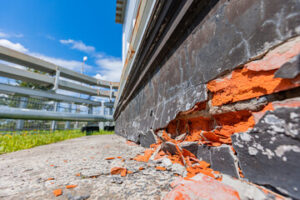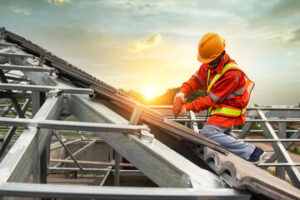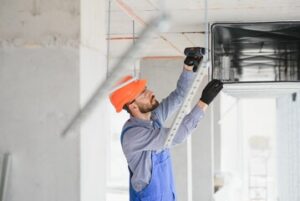Whether you need to address minor hairline cracks or a significant fissure, choosing the right contractor can make all the difference. Look for contractors with local knowledge of soil conditions and building codes.
Watch out for signs of foundation damage such as sloping floors and sticking doors. Addressing these issues promptly can help prevent future damage and costly repairs. Visit https://www.apexplanofoundationrepair.com/ to learn more.

Structural damage to a home’s foundation isn’t something homeowners can ignore. While it may seem like a minor inconvenience at first, cracks in walls or doors that stick are often early warning signs of serious problems – such as foundation shifts and sinking. Addressing these issues promptly is essential to preserving the integrity of the building’s structure and saving money on escalating repair costs.
While quick fixes such as patching or leveling might mask structural damage, these only offer short-term solutions. The underlying causes of these problems are frequently related to unstable soil, caused by factors such as heavy rain or poor landscaping. These shifting soils can leave gaps beneath a foundation, causing uneven support and eventual structural damage to the building.
In order to properly diagnose and repair structural damage, qualified foundation professionals need to inspect the building’s interior and exterior. In addition to identifying and addressing visible cracks, these experts can check the building’s crawlspace for sagging beams that need to be shimmied or replaced. They can also perform a soil test to determine the stability of the ground underneath a house.
Depending on the extent of the damage, it may be necessary to dig and remove part or all of a home’s foundation. This process is often time-consuming and expensive, and it can result in damage to trees, shrubs, walkways, driveways, and other landscaping around the house.
Once the excavation is complete, the repair work can begin. Techniques such as piering and slab jacking correct the instability of a foundation, preventing soil movement and building sinking. These methods can take a few weeks to complete, and they might produce some noise or vibrations. In some cases, it might be necessary to temporarily vacate a home while the repairs are being performed.
After the repair works are completed, homeowners can return to their home. It is normal to see some small cracks re-appear as the house settles, but these can be easily repaired using caulk or putty. Choosing an experienced and reliable foundation repair contractor is the best way to ensure that your home’s foundation remains safe and stable for years to come.
Leaks
Leaks can cause serious problems, from compromising your home’s structural integrity to flooding your basement and damaging your possessions. Water leaks also cause musty odors and can attract mold and pests. If you’ve noticed puddles or standing water in your basement, it’s time to call for foundation repair services.
Often, these leaks are caused by plumbing. As water leaks from pipes and seeps into cracks in your concrete foundation, it can create pressure against the walls and cause them to shift or bow. The pressure can also cause the cracks to widen over time. If you notice these symptoms, it’s important to address the issue quickly to avoid further damage.
The best way to prevent leaks is to make sure your gutters are clean of debris, and that they direct water away from your foundation. You can also install a french drain or other system to divert groundwater and surface water away from your foundation.
If you have a leaky basement, it’s important to have it repaired as soon as possible to avoid more extensive damage and costly repairs. A professional foundation repair contractor will be able to find the source of the leak and seal it so that you can enjoy a dry, comfortable home.
For leaks that occur in wall cracks, epoxy injection is a great option. This is a trenchless method that uses an epoxy or polyurethane foam to fill and seal the crack, keeping water and moisture out of your home. This method is best for small, shallow cracks that haven’t caused major shifts in the foundation.
Other methods include pipe rerouting or re-piping, which involves installing new plumbing lines that bypass the damaged section. This is a good option when the damaged section is a short section of pipe or when the plumbing is encased in concrete and cannot be easily accessed without damaging the slab.
For severe leaks, a full excavation and piering process may be needed. The excavation process can take several days and involve drilling through the foundation, jacking the house up on steel piers, then pumping mud under the foundation to lift it back onto its cured piers. Once the excavation and piering are complete, the home will be secured with steel shims and concrete blocks.
Uneven Floors
When construction contractors lay the foundation for a home or building, they typically compact the soil beneath it. This is intended to help prevent the foundation from shifting over time. However, sometimes the soil becomes too loose or weakened by water damage for the structure to maintain its proper position. This can result in uneven floors.
Uneven floors are a sign that there is a serious problem with your foundation. It is essential to call a professional as soon as you notice them, so that they can determine the cause and recommend the best repair solution for your needs.
Sagging or sloping floors are the most common signs of a foundation issue. These problems can range from a damaged crawl space to foundation settlement or subfloor problems. While you may be tempted to fix these issues with self-leveling concrete, this is only a temporary solution. Instead, a foundation specialist can recommend one of many enduring solutions, such as foam jacking, slab leveling, helical or push piers, or underpinning.
Another common cause of uneven floors is structural wear and tear. This can cause the floor joists to weaken and sag over time. This is especially common in homes with crawl spaces that aren’t properly encapsulated. In these cases, excess moisture accumulates and can weaken wooden floor joists and subflooring. The best way to prevent this is by investing in a quality crawl space encapsulation system, which includes a vapor barrier and venting.
Foundation settlement is another leading cause of uneven floors. This occurs when the soil underneath a home shifts and sinks, causing the foundation to move down or up by several inches. This is most common in clay-based soils, which are found throughout Ohio and Northern Kentucky. In addition to a good soil drainage system, other ways to address this issue include adding a slanting swale or regrading the soil around your foundation.
Mold
Mold growth can be caused by many problems, including foundation cracking and settling. But it can also occur when the soil underneath a foundation shifts, creating hydrostatic pressure that pushes water toward the house. This moisture is a breeding ground for fungi and mold that can affect the health of anyone who lives in a home or office with such a problem.
Mold can be found in any area where there is excess moisture. This includes areas behind and inside walls (where leaking or condensation forms), inside cabinetry where water spills or condensation gathers, in ceiling materials above rooms with a leaky roof, in ductwork and more. Mold spores are floating around indoors all the time, and people don’t usually get sick from them because their concentration is low. But if mold spores land on a wet surface and get stuck, they will begin to grow and release their own spores that can cause mold sickness in people living nearby.
If you suspect that you have a mold problem, don’t try to handle it on your own. Mold is dangerous and can be toxic, so you should leave it to professional mold remediation experts. These experts will safely and thoroughly remove any affected materials and then clean and disinfect the surfaces they removed. They will also test the air to ensure that the spore count is down to safe levels before you return to the area.
Cracking and settling in a foundation can affect doors and windows, making them harder to open and close. It can also lead to floor issues, including warping and unevenness. Poor exterior drainage, shifting soil and flooding of crawl spaces are some of the causes of these problems.
These problems can be prevented by having a professional waterproofing service install a barrier to prevent water from seeping into the basement. You should also ensure that the yard grade slopes away from your home’s foundation and that downspouts are unobstructed and flowing properly. Cleaning and disinfecting any water leaks promptly and drying wet areas and materials within 24-48 hours will help prevent mold growth. Adding fans and keeping humidity levels below 60% will further help.


